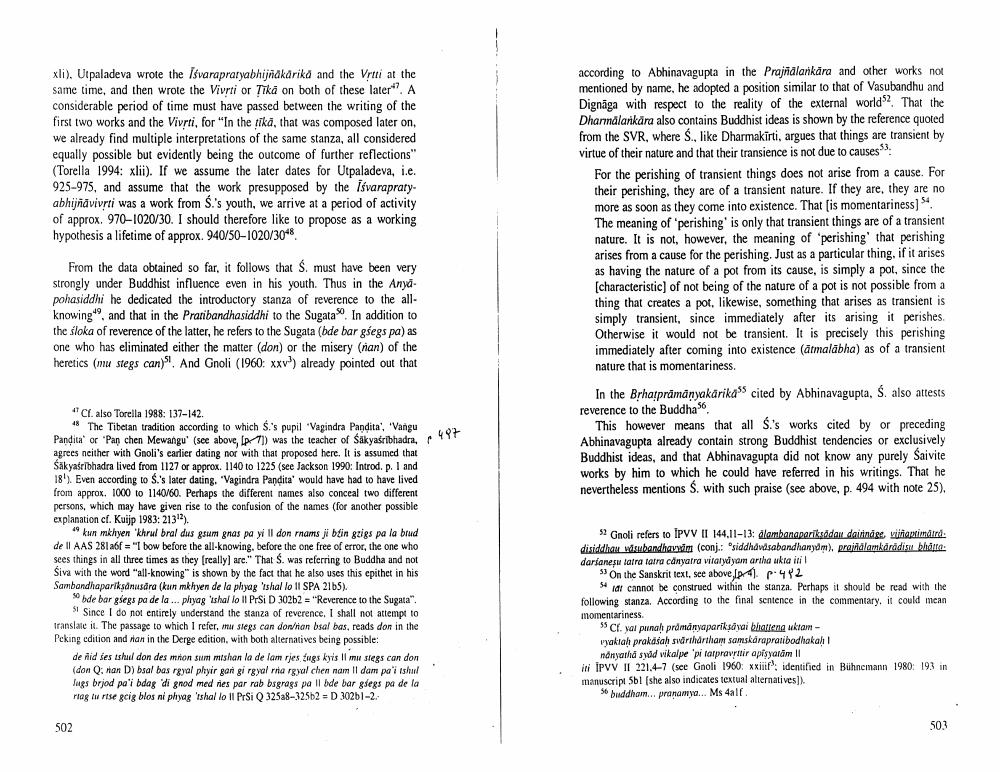________________
xli). Utpaladeva wrote the Isvarapratyabhijndkarika and the Vitti at the same time, and then wrote the Vivrti or Tika on both of these later". A considerable period of time must have passed between the writing of the first two works and the Vivrti, for "In the tika, that was composed later on, we already find multiple interpretations of the same stanza, all considered equally possible but evidently being the outcome of further reflections" (Torella 1994: xlii). If we assume the later dates for Utpaladeva, i.e. 925-975, and assume that the work presupposed by the Isvarapratyabhijñāvivrti was a work from S.'s youth, we arrive at a period of activity of approx. 970-1020/30. I should therefore like to propose as a working hypothesis a lifetime of approx. 940/50-1020/30*
according to Abhinavagupta in the Prajídlankara and other works not mentioned by name, he adopted a position similar to that of Vasubandhu and Dignaga with respect to the reality of the external world. That the Dhandlarikára also contains Buddhist ideas is shown by the reference quoted from the SVR, where S., like Dharmakirti, argues that things are transient by virtue of their nature and that their transience is not due to causes:
For the perishing of transient things does not arise from a cause. For their perishing, they are of a transient nature. If they are, they are no more as soon as they come into existence. That (is momentariness). The meaning of 'perishing' is only that transient things are of a transient nature. It is not, however, the meaning of 'perishing that perishing arises from a cause for the perishing. Just as a particular thing, if it arises as having the nature of a pot from its cause, is simply a pot, since the (characteristic) of not being of the nature of a pot is not possible from a thing that creates a pot, likewise, something that arises as transient is simply transient, since immediately after its arising it perishes Otherwise it would not be transient. It is precisely this perishing immediately after coming into existence (atmalabha) as of a transient nature that is momentariness.
From the data obtained so far, it follows that $. must have been very strongly under Buddhist influence even in his youth. Thus in the Anyd. pohasiddhi he dedicated the introductory stanza of reverence to the allknowing", and that in the Pratibandhasiddhi to the Sugata. In addition to the sloka of reverence of the latter, he refers to the Sugata (bde bar gśegs pa) as one who has eliminated either the matter (don) or the misery (nan) of the heretics (nu stegs can)". And Gnoli (1960: xxv) already pointed out that
In the Brhatprämányakarikas cited by Abhinavagupta, S. also attests reverence to the Buddha
This however means that all S.'s works cited by or preceding Abhinavagupta already contain strong Buddhist tendencies or exclusively Buddhist ideas, and that Abhinavagupta did not know any purely Saivite works by him to which he could have referred in his writings. That he nevertheless mentions S. with such praise (see above, p. 494 with note 25).
"Cf. also Torella 1988: 137-142
48 The Tibetan tradition according to which Ś's pupil 'Vagindra Pandita', 'Vangu Pandita' or 'Pan chen Mewangu' (see above, Ip 11) was the teacher of Sakyasribhadra, agrees neither with Gooli's carlier dating nor with that proposed here. It is assumed that Sakyasribhadra lived from 1127 or approx. 1140 to 1225 (see Jackson 1990: Introd. p. I and 18'). Even according to S.'s later dating. "Vagindra Pandita' would have had to have lived from approx. 1000 to 1140/60. Perhaps the different names also conceal two different persons, which may have given rise to the confusion of the names (for another possible explanation cf. Kuijp 1983: 2132).
"kun mkhyen "khrul bral dus gsum gnas pa yi Il don nams ji bin gzigs pa la brud de ll AAS 281a6f="I bow before the all knowing, before the one free of error, the one who sees things in all three times as they really are." That S. was referring to Buddha and not Siva with the word "all-knowing is shown by the fact that he also uses this epithet in his Sambandhapariksdasdra (kun mkhyen de la phyag 'Ishallo Il SPA 2165)
So bde bar gsegs pa de la... phyag "shallo il Prsi D 30262 = "Reverence to the Sugata".
51 Since I do not entirely understand the stanza of reverence, I shall not attempt to translate it. The passage to which I refer, maslegs can don/rian bsal bas, reads don in the Peking cdition and an in the Derge edition, with both alternatives being possible:
de nid ses shadon des monsum mtshan la de lam rjes tugs kyis Ilmu slegs can don (don Qran D) bsal bas rgyal phyir gan gi rgyalnia rgyal chennam II dam pa'i ishal Sags brjod po i bdag 'di gnod med res par rab bsgrogs pa Il bde bar gsegs pa de la rag luitse geig blos ni phryag 'shal lo ll Prsi Q 325a8-32552 D 30251-2
52 Gnoli refers to IPvy [ 144.11-13: dlambangpariksddan dairinage viiratimdird. disiddhas daubandhand (conj: siddhdudsabandhandm), aralamkaradise bharta darsanesu tafra tatra cdnyatra vitarydym artha akta iti
53 On the Sanskrit text, see above 4 :4 2
Se di cannot be construed within the stanza. Perhaps it should be read with the following stanza. According to the final sentence in the commentary, it could mean momentariness.
55 Cf. vol punak pramanyapariksvai bhalleng wktam
yokia praksah sudrthrtham samskdroprotibodhakah!
nanyathid sydd vikalpe 'pi tapraviti opisyarām 11 iti IPVV II 221.4-7 (see Gnoli 1960: xxii, identified in Bühnemann 1980: 193 in manuscript Sbl (she also indicates textual alternatives]).
58 buddham... prananya... Ms 4all
503




